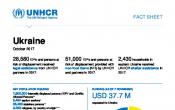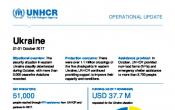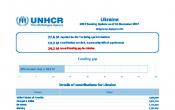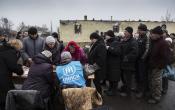Ukraine
For information on UNHCR’s operations in Ukraine prior to 2016, please visit the Regional Office in Ukraine page.
Operation: Ukraine
Location
{"longitude":31,"latitude":49,"zoom_level":5}
Latest update of camps and office locations 21 Nov 2016. By clicking on the icons on the map, additional information is displayed.
Key Figures
| 2018 planning figures | |
| 100% | of primary school-aged refugee children will be enrolled in primary education |
| 90% | of refugees and asylum-seekers will have access to national/government primary health care facilities |
| 70% | of internally displaced households will be living in adequate dwellings |
| 12,000 | IDPs will receive cash grants and another 5,000 IDPs will be provided with non-cash support |
| 9,600 | IDPs will receive shelter support and 6,500 IDPs’ shelters will be repaired or materials for maintenance will be provided |
| 2016 end-year results | |
| 64,300 | IDP households (139,100 individuals) received core relief and/or winterization items |
| 49,500 | IDPs and 3,900 refugees and asylum-seekers were supported with legal aid |
| 8,700 | IDP households received shelter support to repair their houses |
| 5,100 | IDPs and 426 refugees and asylum-seekers received cash assistance |
| 20 | refugees had their naturalization facilitated, while 23 people with undetermined nationality were assisted with confirmation of nationality |
Latest Updates and Related Links
People of Concern
| 2016 | 1,845,246 |

[["Refugees",3302],["Asylum-seekers",6573],["IDPs",1800000],["Returned refugees",8],["Stateless",35363]]
Loading ...
Ukraine
< Back
2016
{"categories":[2013,2014,2015,2016,2017,2018],"budget":[null,null,null,42.25391395,37.65301174,31.086510869],"expenditure":[null,null,null,24.60120571,null,null]}
{"categories":[2013,2014,2015,2016,2017,2018],"p1":[null,null,null,7.1968692,6.7573527,6.029064827],"p2":[null,null,null,0.66575082,0.66464143,0.81654955],"p3":[null,null,null,null,null,null],"p4":[null,null,null,34.39129393,30.23101761,24.240896492]}
{"categories":[2013,2014,2015,2016,2017,2018],"p1":[null,null,null,5.4217403,null,null],"p2":[null,null,null,0.0711454,null,null],"p3":[null,null,null,null,null,null],"p4":[null,null,null,19.10832001,null,null]}
Loading ...
CHOOSE A YEAR
- 2016
- 2017
- 2018
Year-end Overview
Plan Overview
Working environment
As of end-2016, more than 1.6 million people were registered by the Government of Ukraine as internally displaced. UN agencies use a triangulated IDP figure of approximately 800,000 to 1,000,000, as outlined in the 2017 Ukraine Humanitarian Response Plan. UNHCR’s response forms part of inter-agency efforts and focuses on three main objectives: advocating for and responding to the protection needs of conflict-affected people; providing emergency assistance and ensuring non-discriminatory access to quality essential services; and, improving the resilience of people of concern, preventing further degradation of the humanitarian situation, and promoting early recovery and social cohesion.
UNHCR continues to lead the shelter/non-food item (NFI) and the protection clusters. The security situation in eastern Ukraine remains volatile and can hinder delivery of humanitarian assistance to people in need. It is hoped that the resolution of obstacles to humanitarian access in non-government controlled areas will enable UNHCR to enhance its assistance delivery.
Challenges remain in securing protection and durable solutions for IDPs and other conflict-affected people, including restrictions on freedom of movement and humanitarian access to affected populations. Long delays, including overnight stops, at crossing points put civilians at risk, especially people with specific needs. UNHCR continues to support measures to facilitate and expedite crossings. The situation of people residing close to the line of contact remains especially concerning, as they lack access to regular services and protection, including social benefits and pensions. UNHCR continues to work closely with community-based organizations to support IDPs and people at risk of displacement.
Although no major new displacement is expected in 2018, in view of the challenging economic situation, many residents of non-government controlled areas may continue to move to government-controlled areas or to commute across the line of contact. It is assumed that the number of IDPs will slightly decrease throughout the years.
As of November 2017, Ukraine was hosting some 3,253 refugees and 5,464 asylum-seekers. The majority of refugees and asylum-seekers originated from Afghanistan and the Syrian Arab Republic, with more than 70 other countries of origin also represented. More than 35,000 persons were estimated to be stateless as of end-2016. UNHCR will continue to work with the Government to bring the national asylum system in line with international standards, including in terms of prospects for local integration of refugees. Several important legislative initiatives relating to the asylum system have been recently adopted, such as amendments to the Refugee Law in the area of registration (improvement of the recording of personal data) and adoption of joint State Migration Service and State Border Guard Service instructions concerning transfer of asylum applications.
UNHCR will support the Government in adopting legislation to ensure that no child is born stateless, protection status and documentation are issued to stateless persons, and birth registration is issued for prevention of statelessness. Moreover, UNHCR will advocate for the introduction of simplified procedures for issuing birth certificates for babies born in the non-governmental controlled areas. UNHCR will also provide legal counselling/representation related to the prevention of statelessness, as well as to stateless persons on obtaining statelessness documents and on naturalization.
Key priorities
In 2018 UNHCR will focus on:
- Continuing to lead the shelter/NFI and the protection clusters, and fostering partnerships with IDP communities, international organizations, civil society, and central and local governments;
- Strengthening UNHCR’s presence in areas with large numbers of IDPs;
- Maintaining a strong protection monitoring and advocacy role and promoting access to durable solutions for IDPs (local integration or return);
- Responding to protection concerns of and acute humanitarian gaps faced by IDPs and vulnerable populations/communities by: providing cash grants, legal and social counselling, as well as life-saving NFIs and shelter support for those at highest risk; implementing community projects for people with specific needs in non-government controlled areas and along the contact line; and fostering peaceful coexistence between IDPs and host communities;
- Ensuring the continuing participation of the Government in the regional quality assurance initiative in Eastern Europe and the South Caucasus, with the aim of strengthening asylum procedures by conducting capacity building for first instance decision makers, the judiciary, and border guards; and
- Supporting the Government in the identification of stateless persons and developing relevant legislation to end statelessness, including through the establishment of a statelessness determination procedure.




